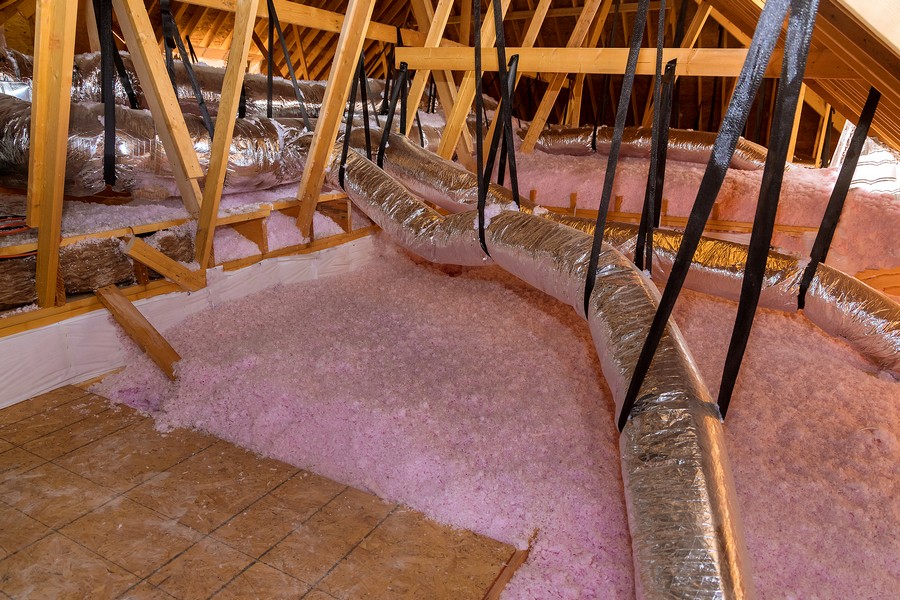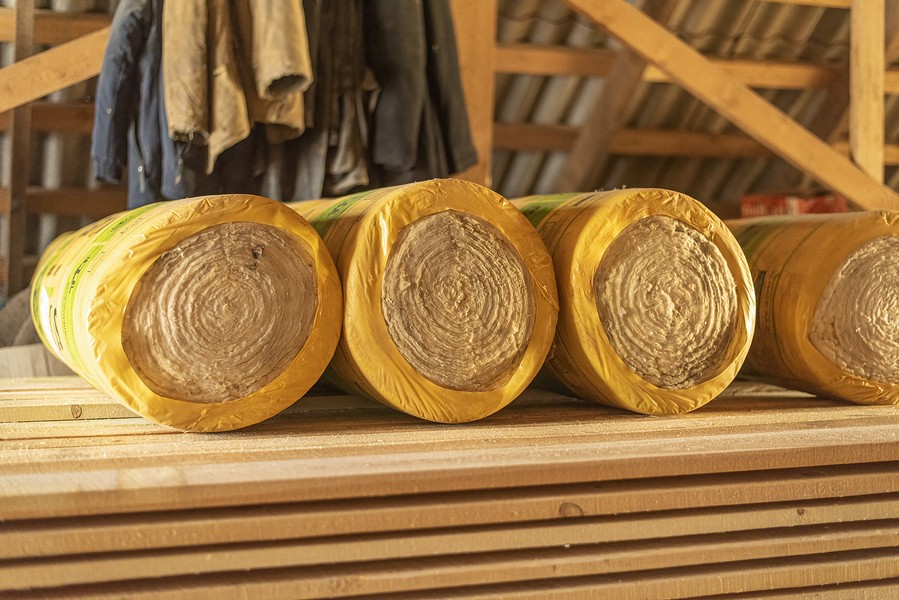insulation contractors
Is your attic drafty? Is your crawl space drafty? Are heating and cooling bills too high??
If your answer yes to any of these questions, then perhaps it’s about time you may need to consider investing in some insulation for your home. Insulation helps to keep the heat in during the winter and the cool air in during the summer, which can save you money in the long run.
At Jackson Insulation & Exteriors, we use only the highest quality insulation products on the market, and we offer free estimates for all prospective clients in Genoa, Lakemoor, Wauconda, Waukegan, and nearby areas. Whether you need new or additional insulation for your attic, walls, or crawl space, we offer a service to meet your needs.
What Is an Insulation?

Insulation is a material that is used to prevent heat, cold, or sound from entering or escaping a building. The most popular used in homes in Genoa is made from fiberglass, though there are other materials used for insulation, such as cellulose, wool, and foam. Insulation is commonly installed in walls, floors, ceilings, and crawl spaces; it could also be installed in doors or windows. It is considered an important part of energy efficiency and can save homeowners in Genoa, money on their electric utility bills. Insulation works by creating a barrier between two areas that would otherwise be in contact with each other. This barrier can be created in a number of different ways, depending on the type of insulation. For instance, some types of insulation work by reflecting heat, while others work by absorbing it. It is also effective at reducing noise in the neighborhood. When selecting insulation for a home in Genoa, it is important to consider the climate, the type of building, and the desired level of comfort.
Why Do You Need to Install an Insulation?
There are numerous reasons why a homeowner must install insulation inside their homes. Such benefits are the following:
- Insulation provides more comfort to your home – There are a number of ways that insulation can provide more comfort to your home in Lakemoor. During wintertime, insulation helps to trap the heat inside your home, making it warmer and more comfortable. During the summertime, when the sun is at its peak, insulation helps prevent the heat from coming in, making indoor spaces cooler and more comfortable. Insulation also helps to reduce noise pollution, creating a quieter and more peaceful environment. It also keeps the air quality in your home in Lakemoor clean by keeping pollutants out and moisture-rich air inside.
- R-value, or thermal resistance value, measures how well insulation resists heat flow. The higher the R-value, the better insulation performs in resisting heat flow.
- Insulation can help prevent moisture problems in your home by reducing drafts caused by wind passing through walls and ceilings. Insulating your attic and basement can help keep them dryer, so mold doesn’t grow as easily.
- Insulation helps lower energy costs – Many homeowners in Lakemoor are searching for ways to lower their energy costs, and insulation is one of the most effective ways to do so. Insulation works by creating a barrier that prevents heat from escaping through walls, ceilings, and floors. By slowing down the transfer of heat and temperature, insulation helps maintain the present temperature inside a home, thus reducing the need to adjust and use air conditioning or heating appliances. This can help reduce energy consumption and ultimately save money on utility bills! It is available in a variety of thicknesses, and it can be installed in new construction or retrofitted into existing homes. The benefits of insulation make it an appealing option for homeowners who are looking for ways to reduce their energy costs.
- Insulation is environmental-friendly – Insulating your home in Wauconda helps reduce greenhouse gas emissions by reducing the number of fossil fuels burned to generate electricity or heat water. It also reduces emissions from driving to work or school, as well as contributes to lower levels of air pollution in your community.
- Insulation helps with outside noises – It is not uncommon that outside noises can be a source of stress and anxiety. Whether it’s the sound of traffic on a busy street in Wauconda or the sound of your neighbor’s dog barking, unwanted noise can make it difficult to relax and enjoy your home. An efficient and proven way to reduce outside noise is by installing insulation products inside your home. Thick walls and insulation help to soundproof your home, making it more peaceful and quieter. Another important way in which insulation helps stop outside noises coming into your home is by using double glazing on all of your windows as this prevents any noise from getting through them as they are designed to only allow light through but not sound!
What Kind of Insulation Is Best for Your Home?
Whether your purpose is for energy conservation or controlling outside noises, homeowners must know the different kinds of insulation to know which would be the best for their homes. There are different types of insulation available in Wauconda, and each one has its own benefits and drawbacks. In this section, we’ll take a look at the information on the most common types. So, if you’re considering adding insulation to your home, be sure to read on.
Blanket Batts and Rolls
Blanket batts and rolls are two types of insulation that are often used in construction. Rolls are larger and thinner than a batt, making them easier to install in tight spaces. Blanket batts are made of fiberglass, cellulose, or rock wool, while rolls can be made of fiberglass, foam, or reflectix. Both of these types of insulation have their own advantages and disadvantages, thus, it’s important to consider the purpose and nature of your project to know which one is best for you. Rolls are more expensive than batts, but they’re also more effective at preventing heat loss. Blanket batts are less expensive and easier to install, but they don’t provide as much insulation as rolls. Ultimately, the decision between rolls and batts should be based on your budget and the specific needs of your project.
Spray Foam Insulation
Spray foam insulation is a type of insulation that is sprayed onto a surface in order to provide a layer of protection. The most common type of spray foam insulation is made from polyurethane, which is a material that can be either rigid or flexible. It is often used in home and commercial construction projects. The spray foam insulation expands once it is sprayed onto a surface and then hardens in order to create a protective barrier. This barrier helps to keep heat in or out of an area, depending on the needs of the project. In addition to its insulating properties, spray foam insulation also has the ability to seal off cracks and gaps that might otherwise allow air or water to leak through. As a result, spray foam insulation is an effective way to improve the energy efficiency of a home or building.
Blown-in Insulation
Blown-in insulation is a type of insulating material that is applied using a special blowing machine. The machine blows the insulation into place, filling in the spaces between studs, joists, and other framing members. Blown-in insulation is often made of fiberglass or cellulose fibers, and it can be used in both new construction and retrofit project in Waukegans. One advantage of this kind of insulation is that it is well-suited for areas that are hard to reach such as attics and crawl spaces. Additionally, blown-in insulation forms a tight seal that helps to prevent air leaks. As a result, it can be an effective way to improve the energy efficiency of your home.
Foam Board or Rigid Foam Panels
Foam board, also known as rigid foam panels, is an inexpensive and lightweight material used for construction and crafts projects. The material is made from a variety of plastics, including polystyrene, polyethylene, and PVC. Foam board is available in a range of densities, thicknesses, and sizes. It is often used as an alternative to fiberglass insulation in both commercial and residential construction projects in Waukegan. Since foam board insulation is not only easy to install but can also be customized to fit any space and size, it is most commonly used for walls, ceilings, and floors. Foam board is not structural; it cannot be used to support weighty objects. The material is flammable; however, it can be coated with fire-retardant chemicals to reduce its flammability. Foam board is an excellent choice for many construction and craft projects due to its low cost, ease of use, and versatility.
Rockwool Insulation
From the word itself, Rockwool insulation is a type of insulation made from rock or stone. It is utilized most frequently for applications in basements and attics, in addition to serving as insulation for HVAC ductwork. Rockwool insulation is made by heating rocks or minerals to a high temperature and then spinning the molten material into fibers. The resulting material is lightweight, non-combustible, and resistant to mold and moisture. Rockwool insulation can be installed using batts, blankets, or loose fill.
Loose-fill/Cellulose Insulation
Loose-fill insulation, also known as cellulose insulation, is a type of insulating material made from recycled paper products. It is often used in attics and walls to help draft-proof and weatherproof a home. The material is made up of small pieces of cloth or padding that are designed to fit tightly together. When properly installed, loose-fill insulation can have an R-value of 3.7 to 4.0 per inch. This means that it can be very effective at keeping a home warm in the winter and cool in the summer. In addition to its excellent insulating properties, loose-fill insulation is also fire-resistant and does not settle over time like other types of insulation. As a result, it is an ideal choice for homes in any climate in Waukegan.
Structural Insulated Panels
Structural Insulated Panels, more commonly known as SIPs, are a type of panel that is used in the construction industry. They are made by sandwiching a layer of foam between two pieces of plywood or oriented strand board. There are a few other materials that can be used to make the foam, but polystyrene is by far the most prevalent one. The thickness of the panels can range anywhere from four to eight inches, with the majority falling somewhere in that range. SIPs can help to keep the interior of a building at a pleasant temperature throughout the year, even in areas where winters are cold, and summers are hot. This is especially useful in climates where summers are hot. They are also very effective in keeping out moisture, making them an ideal choice for use in humid climates. Another value of SIPs is that they are very strong and durable. They are often used in areas that experience high winds or seismic activity, as they can resist damage from these forces better than traditional construction methods can.
Insulating Concrete Forms (ICFs)
Insulating Concrete Forms, or ICFs, are a type of construction material used to create energy-efficient and disaster-resistant buildings. The forms are made of interlocking blocks or panels of polystyrene foam, which are then filled with concrete. This creates a strong bond between the concrete and the foam, resulting in a highly insulated and durable wall system. ICFs have been used in a variety of commercial and residential applications and are particularly well-suited for tornado- and hurricane-prone areas. In addition to their strength and resilience, ICFs also offer excellent soundproofing properties and can help to reduce energy costs by up to 50%.
Concrete Block Insulation
Concrete block insulation is a type of insulation that is placed between the inner and outer walls of a concrete block. This type of insulation is often used in commercial and industrial buildings, as well as in homes. There are two main types of concrete block insulation: rigid and loose-fill. Rigid concrete block insulation is made from Styrofoam or another type of foam material. It is cut to fit snugly between the blocks and then secured in place with adhesive. Loose-fill concrete block insulation is made from fiberglass or cellulose fibers. It is blown into the space between the blocks and then left in place to dry. Both types of insulation have the potential to do a good job of preventing heat from escaping through the walls of a concrete block, but they do it in different ways and come with their own sets of benefits and drawbacks. Rigid concrete block insulation is more expensive than loose fill, but it is easier to install and does not require as much maintenance. Loose-fill concrete block insulation is less expensive, but it can be more difficult to install and may require more maintenance over time.
Jackson Insulation & Exteriors Co., Inc. Provides the Best Insulation Services

When it comes to questions about home insulation, our company has the answers. Jackson Insulation & Exteriors Co. provides the best insulation services in Genoa, Lakemoor, Wauconda, Waukegan, and nearby areas. There are a variety of insulation products, and it can be difficult to find the right model for your home. Installation may be tricky; thus, it is best to hire a professional to ensure effectiveness.
We provide a variety of services to ensure that your home is properly insulated, both for performance and for safety. We also offer tips on how to get the most out of your insulation and how to keep it in good condition. Additionally, we can help you with weatherproofing your home to make sure that it is protected from different weather conditions and outside elements. Contact us today to learn more about our insulation services and how we can help you save money on your energy bills.
We provide expert installation of the following:
Retrofit
- Blown-in Attic Insulation using premium fiberglass from leading manufacturers
- Blown-in Wall Insulation using fiberglass and cellulose fiber from leading manufacturers
- Crawl space insulation using fiberglass and styrofoam
- Air Sealing of attics
New Construction
- Fiberglass Batts and Blown-In Insulation
- Firecaulking
- Vapor Barrier
Jackson Insulation & Exteriors Co
- Fully Insured
- 5-year Warranty on all workmanship
- Industry Best Warranty on materials from Major Manufacturers
Our products separate people from the elements and our workmanship separate us from all others…




